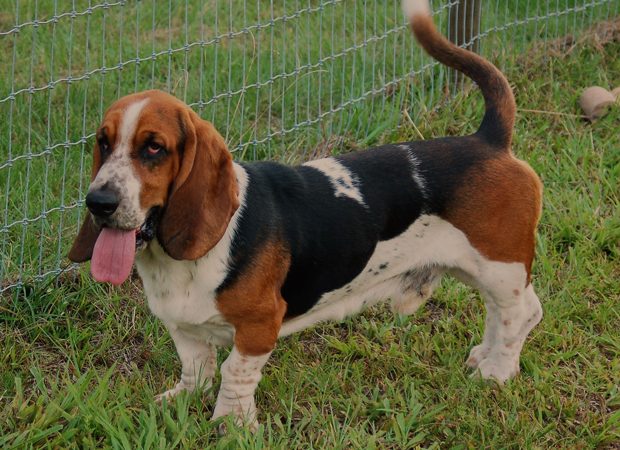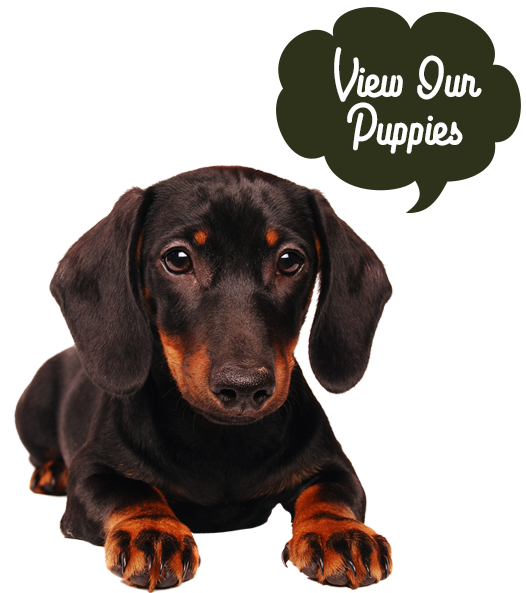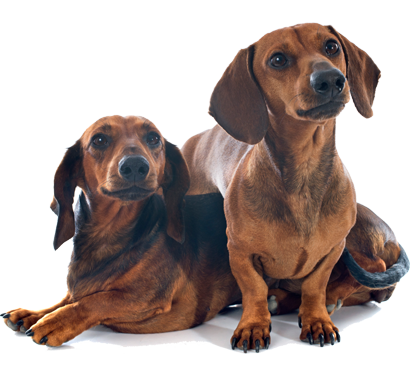
From Cody, Our Breeder & Animal Specialist:
Genetics is something I find extremely interesting to study. It’s really cool to learn the genetics of your animal(s) and see what comes from different mating's. I started my journey at the University of Florida in 2018 majoring in Animal Sciences and have taken genetics classes.
Some basic genetic information and a very popular question we get asked regularly is, “what does F1, F1B, F2, etc. mean?”. These terms refer to the generation of the crossbreed. Below you will find several categories with basic genetic information based on my studies and experience.
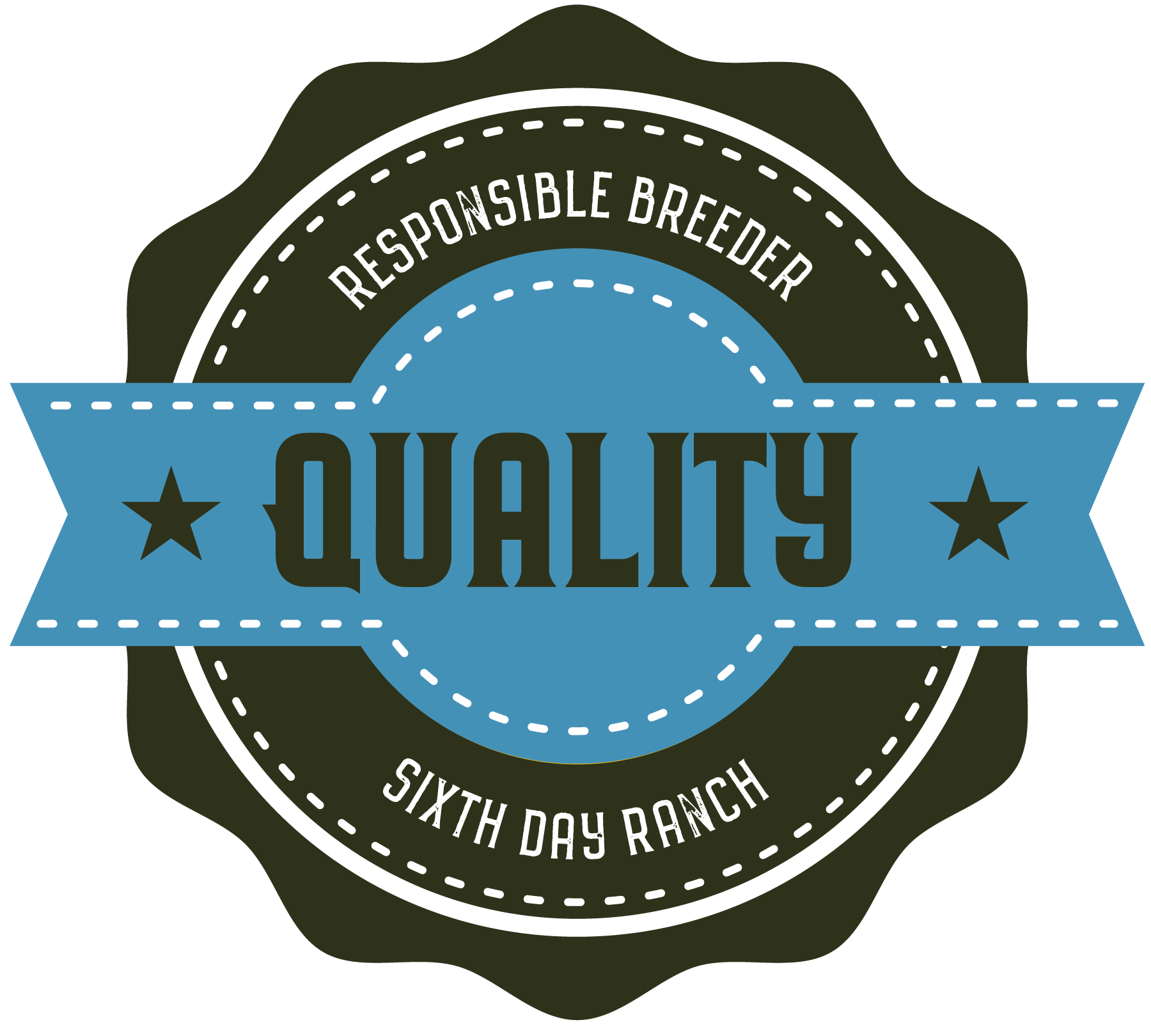
Animal Genetics
Basic animal genetic information


 Animal Generations
Animal Generations
 Color Genetics
Color Genetics
 Gene Dominance
Gene Dominance
 Pattern Dominance
Pattern Dominance
 Incomplete Dominance
Incomplete Dominance
 Different Patterns
Different Patterns
 Genotypes
Genotypes
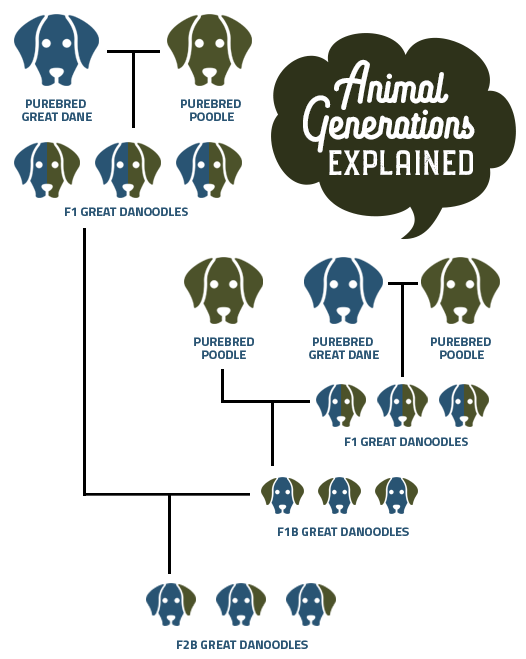
- F1 means a first generation cross. For example, this would be a cross between a purebred Great Dane and a purebred Poodle (50/50 cross). This generation will still shed some but usually not as much as the purebred non-poodle parent.
- F1B is what’s known as a backcross to one of the parent breeds. For this you take an F1 (first generation) and breed it back to one of the breeds that makes up the cross. With the doodles the most popular F1B is the F1 bred back to a poodle. This creates the more desired coat and generally minimal to no shedding. So for example, statistically an F1B is 75% poodle and 25% Great Dane (or whatever other breed was crossed with the poodle to create the F1) in the case of the Great Danoodle.
- F2 means you take two F1 (first generation) crosses and breed them together. This cross can create puppies that look like either of the parent breeds or any combination in between. This is not as much of a popular cross since the outcome of the puppies is so varying.
- F2B is essentially the same type of cross as the F1B, except you are taking a F2 (second generation) cross and breeding it back to one of the parent breeds. That is one way to create this cross, but there is also a second way to get F2B This way consists of taking a F1 and breeding to a F1B. This generation will vary in coat types depending on which way you use to get the F2B puppies.
- F3 or Multigenerational puppies can be created by many different ways but the most common way is to breed F1B to F1B. These puppies usually have very nice coats with minimal to no shedding. This will be the primary way we use to get our multigenerational
- Chromosome – a structure found in most living cells, carrying genetic information in the form of genes
- Gene – a unit that is passed down from parent to offspring and determines some characteristics of the offspring
- Locus – a fixed position on a chromosome
- Allele – one of two or more alternative forms of a gene that are found at the same place on a chromosome
- Dominant allele – covers up the contribution of the second (recessive) allele and has to be exhibited if present on the gene (with the exception of hidden or cryptic merle). Dominant alleles are represented by a capital letter.
- Recessive allele – a version of a gene that must have two copies (homozygous) to be exhibited, therefore this allele can be carried. Recessive alleles are represented by a lowercase letter.
- Homozygous – when a gene has two identical alleles on a chromosome. For example, “BB” or “bb”.
- Heterozygous – when a gene has one copy of the dominant allele and one copy of the recessive allele. For example, “Bb”.
- Complete dominance – the most common form of dominance, where the dominant allele covers up the contribution of the recessive allele
- Incomplete dominance – a tricky form of dominance, where the dominant and recessive alleles create a combination of the two alleles which makes a third phenotype. For example, with shorthorn cattle, RR = red, Rr = roan, rr = white.
- Genotype – the genetic makeup of an organism
- Phenotype – the physical appearance of an organism
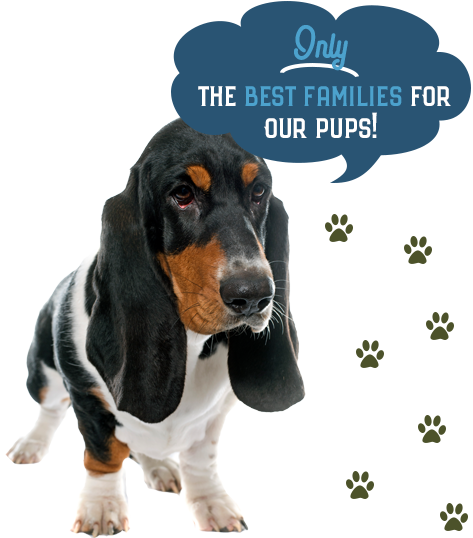
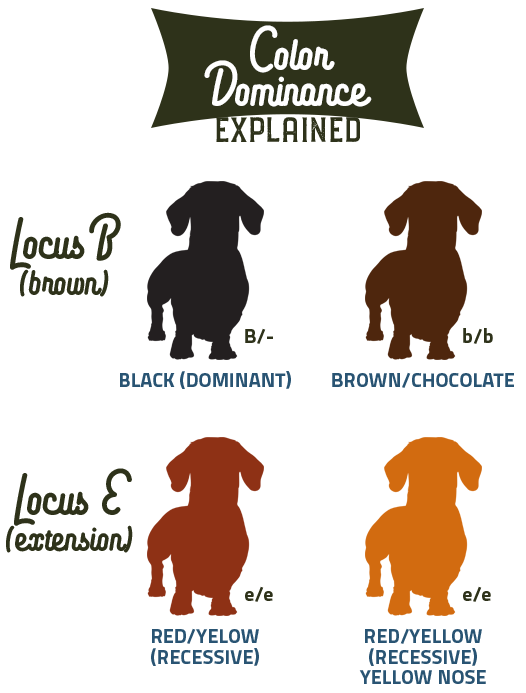
The following are color genes that exhibit complete dominance
- B (Brown) Locus: B represents black (dominant allele), while b represents brown/chocolate (recessive allele). These are only base colors, there are several other genes that can affect hair color and/or patterns. BB is a black based dog that can only produces black based puppies. Bb is a black based dog that carries brown/chocolate that means this dog can produce brown/chocolate when bred to a brown/chocolate or another carrier. A bb is a brown/chocolate-based dog, this gene is recessive so it can only be produced when bred to another bb or a Bb.
- E (Extension) Locus: E represents black or brown/chocolate which means it has no effect on hair color (dominant allele), while e represents red/apricot/cream/white (recessive allele). EE is a dog that is whatever color he/she has as it’s base color and can only produces puppies that are a base color. Ee is a base colored dog that carries red/apricot/cream/white that means this dog can produce red/apricot/cream/white when bred to a red/apricot/cream/white or another carrier. An ee is a red/apricot/cream/white dog, this gene is recessive so it can only be produced when bred to another ee or an Ee.
- D (Dilute) Locus: D represents black or brown/chocolate which means it is not a dilute (dominant allele), while d represents blue or isabella (recessive allele). DD is a dog that is whatever color he/she has as its base color and can only produces puppies that are a base color. Dd is a base colored dog that carries blue or isabella that means this dog can produce blue or isabella when bred to a blue or isabella or another carrier. A dd is a blue or isabella dog, this gene is recessive so it can only be produced when bred to another dd or a Dd.
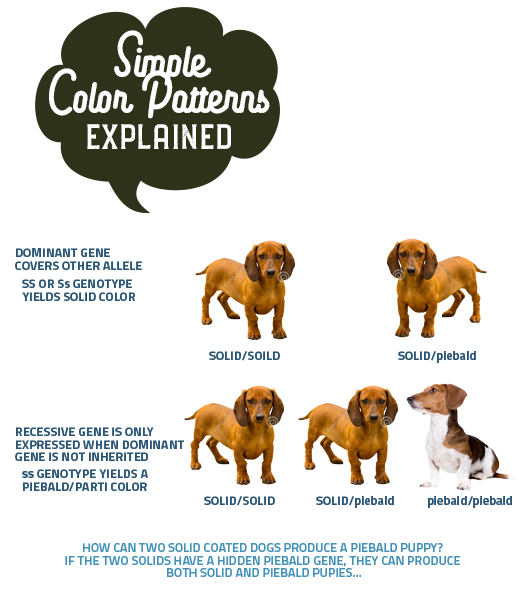
These color patterns exhibit complete dominance:
- M (Merle) Locus: M represents merle (dominant allele), while m represents non-merle (recessive allele). MM is a double merle dog, the result of breeding two merles together. #1 Rule with merle is never breed two merles together, this creates double merles which can be blind and/or deaf. Mm is a merle dog that should only be bred to non-merles, that cross should get you statistically 50% merle puppies and 50% non-merle puppies. A mm is a non-merle dog, this gene is recessive so it will produce all non-merle puppies when bred to other non-merles.
- S (Spotting) Locus: S represents a solid colored dog (dominant allele), while s represents piebald/parti (recessive allele). SS is a dog that is solid colored and can only produces puppies that are solid colored. Ss is a solid colored dog that carries piebald/parti that means this dog can produce piebald/parti when bred to a piebald/parti or another carrier. A ss is a piebald/parti dog, this gene is recessive so it can only be produced when bred to another ss or a Ss.
A color pattern that exhibits incomplete dominance:
- T (Ticking) Locus: T represents a dog with ticking/speckles (dominant allele), while t represents a dog with no ticking/speckles (recessive allele). This color pattern is still under quite a bit of testing and research to determine its exact representation, but this is the best-known understanding. TT is a dog with heavy ticking and should produce puppies that all have ticking. Tt is a dog with light to moderate ticking and can produce puppies with heavy ticking, light to moderate ticking, or no ticking depending on what its bred too. tt is a dog with no ticking and will only produce ticking if bred to a dog that exhibits ticking.
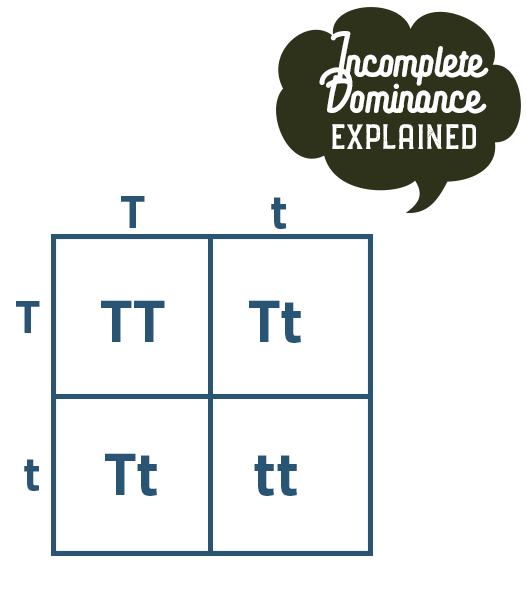
Let’s make things a little more complicated. The following loci work in conjunction with each other to produce different coat patterns.
- K (Dominant Black) Locus: The K locus is dependent on the E locus, which means the K locus is not expressed if the recessive version (ee) of the E Locus is present. The K locus is only expressed when the E locus is EE or Ee. There are three different alleles associated with this gene, KB, Kbr, and Ky.
- KB is the most dominant allele and is noted as dominant black, if a dog is KBKB, KBKbr, or KBKy at the K locus it will not express any hidden genes. Kbr represents the “brindling” allele and is recessive to KB , but dominant to Ky.
- Kbr allows the A locus to be expressed, however it causes a brindling on the agouti pattern. Therefore, any dog that is KbrKbror KbrKy at the K locus will allow the A locus to be expressed along with a brindle pattern.
- Ky allows the A locus to be expressed without brindling. It is the most recessive allele on the K locus. Any dog that is KyKy at the K locus will allow the agouti pattern to be expressed.
- A (Agouti) Locus: The A locus is dependent on the K locus and the E locus. The E locus must be EE or Ee with the K locus being KbrKbr, KbrKy, or KyKy in order for the A locus to be expressed. There are four different alleles associated with this gene, Ay, aw, at, and a.
- Ay is the most dominant allele on the A locus and is responsible for the fawn and sable patterns on dogs. This allele can carry any of the other three alleles on this locus, but it does not allow them to be expressed. A fawn or sable dog can have any of the following pairs of alleles, AyAy, Ayaw, Ayat, or Aya.
- aw is recessive to Ay, but dominant to at and a. aw is known as “wild sable” (German Shepherd pattern). This allele can hide either of the two more recessive variants. A wild sable dog can have any of the following pairs of alleles, awaw, awat, or awa.
- at is recessive to Ay and aw, but dominant to a. at is responsible for tan points on the eyebrows, lips, and feet/legs (like seen in Dobermans and Dachshunds). This allele can hide the recessive a allele. A tan pointed dog can have either of the following pairs of alleles, atat or ata.
- a is the most recessive allele on the A locus and represents solid or bicolor with no extra patterns. This allele has no effect on coat pattern and the dog will have whatever color it’s other genes represent. The only option for a dog with these alleles is aa.
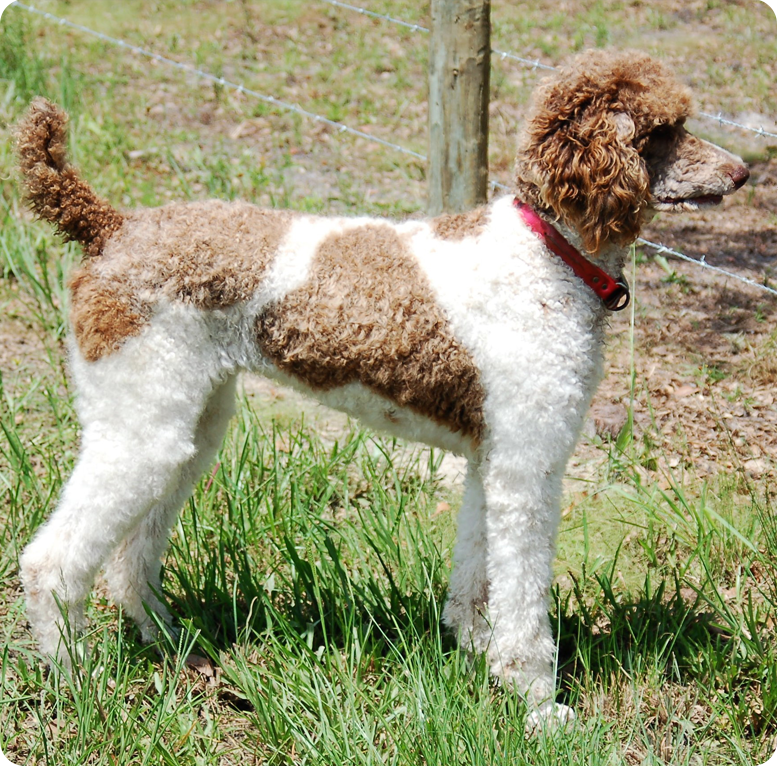
There are several other genes that go into a dog’s coat color and pattern but these are the basics. A dog’s genotype can look something like these:
- Bb, Dd, EE, mm, Ss, _ _ (ticking is unknown), KBKB, Ayat: This is the genotype of Izzy our F1 Labradoodle. She is solid black and carries brown/chocolate, blue or Isabella, and piebald/parti.
- bb, DD, Ee, mm, ss, Tt, KBKy, ata: This is the genotype of Jewlz our Standard Poodle. She is a chocolate parti with light ticking and carries red/apricot/cream/white and phantom/tan points.
- BB, DD, Ee, Mm, Ss, tt, KBKy, atat: This is the genotype of Chanel our F1B Great Danoodle. She is a blue merle and carries red/apricot/cream/white, piebald/parti, and phantom/tan points.
- bb, DD, ee, mm, SS, tt, _ _ (K unknown), _ _ (A unknown): This is the genotype of Benelli our Labrador Retriever. She is a chocolate based yellow.
- B_ (recessive allele is unknown), DD, EE, mm, ss, TT, KyKy, atat: This is the genotype of Zoe our Mini Dachshund. She is a black & tan piebald with heavy ticking.
Compassionate
towards
animals
people with heart of gold
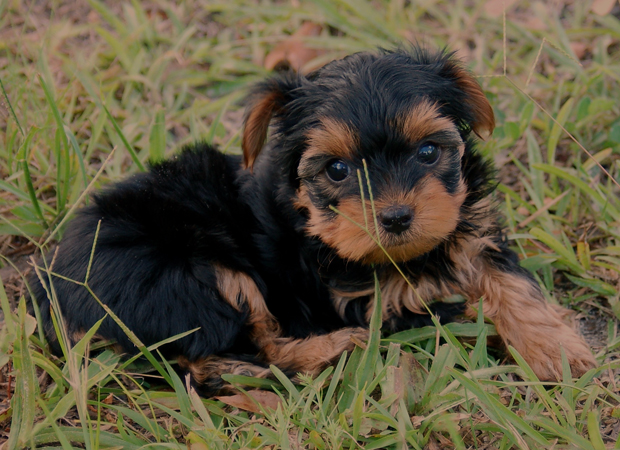
Ready to Adopt
call us @
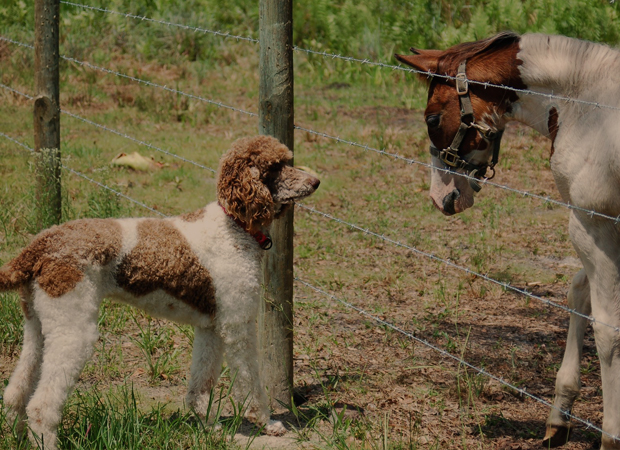
Follow Us On Facebook
For Regular Updates
